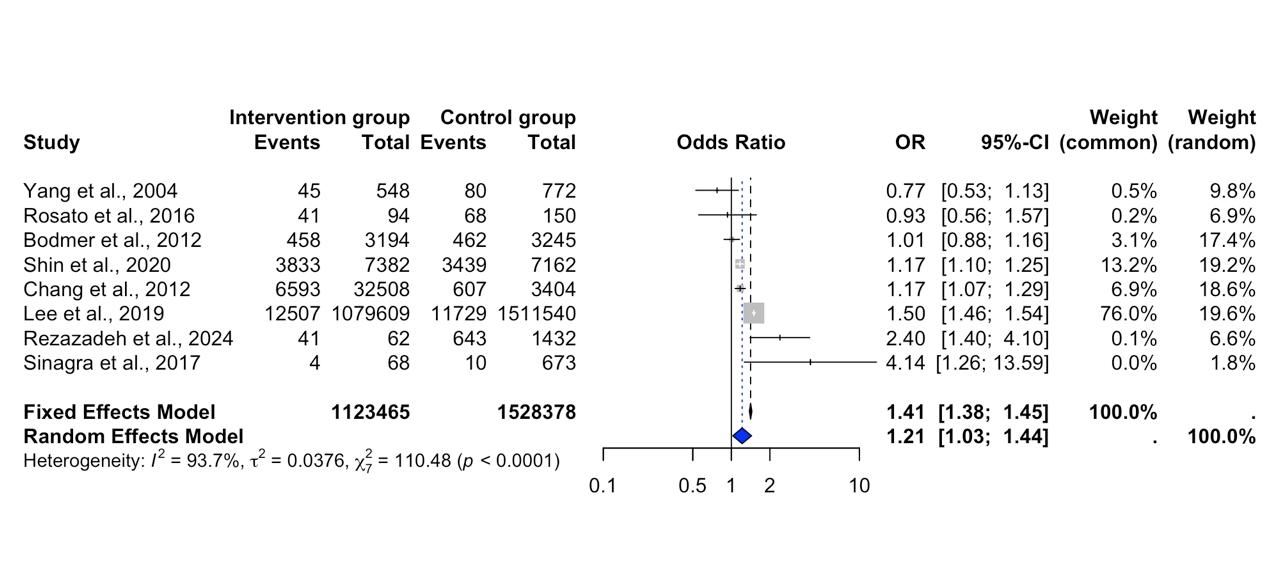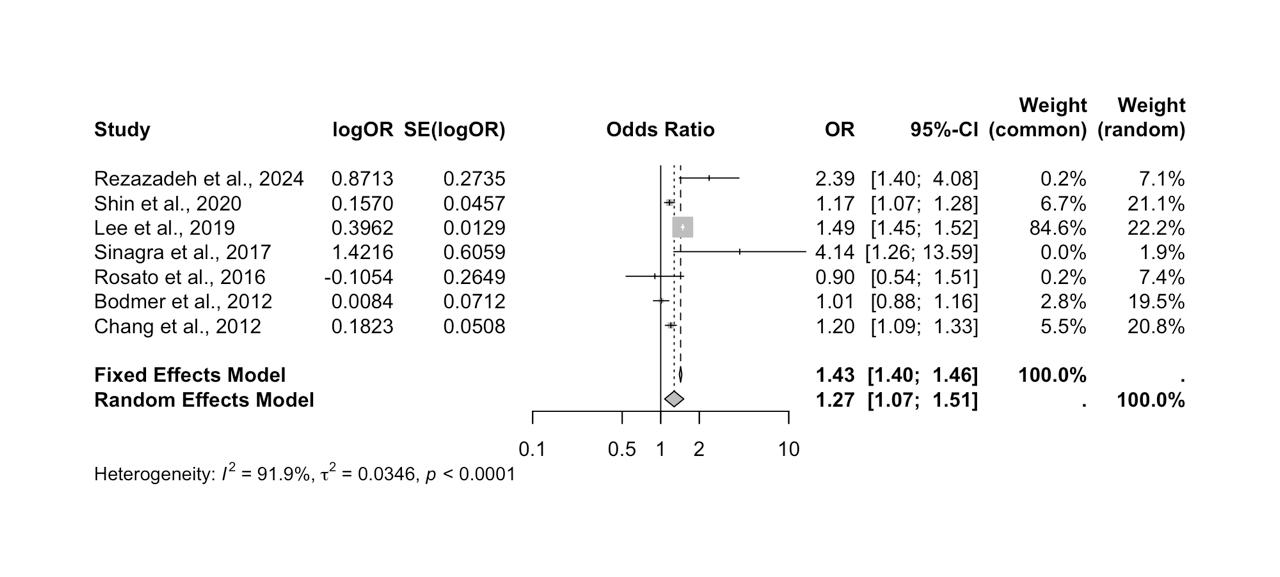Sunday Poster Session
Category: Colorectal Cancer Prevention
P0517 - Sulfonylurea Use and Colorectal Cancer Risk: A Systematic Review and Meta-Analysis
Sunday, October 26, 2025
3:30 PM - 7:00 PM PDT
Location: Exhibit Hall

Ahmad Al Homaid, MD
Nazareth Hospital
Philadelphia, PA
Presenting Author(s)
Ahmad Alhomaid, MD1, Pranav Patel, MD2, Rumael Jawed, MD1, Elias Helal, MD1, Giorgi Chillingarashvili, MD1, Giorgi Maisuradze, MD3, Harshit S. Khara, MD4, Bradley D. Confer, DO2
1Nazareth Hospital, Philadelphia, PA; 2Geisinger Health System, Danville, PA; 3Tbilisi State Medical University, Tbilisi, T'bilisi, Georgia; 4Geisinger Health System, Danville, NJ
Introduction: Sulfonylureas, one of the oldest and most widely prescribed class of oral antidiabetic medications, work by stimulating insulin secretion from pancreatic beta cells. While their efficacy in diabetes management is well-established, concerns exist regarding their potential impact on colorectal cancer. We conducted a systematic review and meta-analysis to evaluate this relationship.
Methods: We systematically searched PubMed, Scopus, and Google Scholar databases through October 2024. Pooled odds ratios (ORs) with 95% confidence intervals (CIs) were calculated using both reported effect estimates and raw event data. Heterogeneity was assessed using the I2 statistic, tau2 and Cochran’s Q test. Random-effects models were used to account for between-study variations.
Results: Eight observational studies involving 2,651,843 participants were included. Analysis of raw event data showed 23,522 CRC events in the sulfonylurea group compared to 17,038 events in the control group, demonstrating a significantly increased risk of colorectal cancer with sulfonylurea use (OR = 1.41, 95% CI: 1.38-1.45). Random effects model accounting for between-study variations yielded a more conservative but still significant association (OR = 1.21, 95% CI: 1.03-1.44). This finding was consistent with the pooled analysis of reported effect estimates (random-effects OR = 1.27, 95% CI: 1.07-1.51).
Discussion: This meta-analysis suggests that sulfonylurea use may be associated with an increase in colorectal cancer risk. These findings could have implications for risk stratification and screening strategies in diabetic patients using sulfonylureas. Future prospective studies should focus on potential mechanisms underlying this association and dose-response relationships.

Figure: Forest plot of odds ratios for intervention versus control groups across 8 studies. Random effects meta-analysis shows pooled OR of 1.21 (95% CI: 1.03-1.44) with significant heterogeneity (I²=93.7%, p<0.0001). The diamond represents the overall pooled estimate, with individual study estimates shown as squares sized by weight.

Figure: Forest plot of odds ratios from 7 studies with log-transformed data. Random effects meta-analysis shows pooled OR of 1.27 (95% CI: 1.07-1.51) with high heterogeneity (I²=91.9%, p<0.0001). The diamond represents the overall pooled estimate, with individual study estimates shown as squares sized by weight
Disclosures:
Ahmad Alhomaid indicated no relevant financial relationships.
Pranav Patel indicated no relevant financial relationships.
Rumael Jawed indicated no relevant financial relationships.
Elias Helal indicated no relevant financial relationships.
Giorgi Chillingarashvili indicated no relevant financial relationships.
Giorgi Maisuradze indicated no relevant financial relationships.
Harshit Khara indicated no relevant financial relationships.
Bradley Confer indicated no relevant financial relationships.
Ahmad Alhomaid, MD1, Pranav Patel, MD2, Rumael Jawed, MD1, Elias Helal, MD1, Giorgi Chillingarashvili, MD1, Giorgi Maisuradze, MD3, Harshit S. Khara, MD4, Bradley D. Confer, DO2. P0517 - Sulfonylurea Use and Colorectal Cancer Risk: A Systematic Review and Meta-Analysis, ACG 2025 Annual Scientific Meeting Abstracts. Phoenix, AZ: American College of Gastroenterology.
1Nazareth Hospital, Philadelphia, PA; 2Geisinger Health System, Danville, PA; 3Tbilisi State Medical University, Tbilisi, T'bilisi, Georgia; 4Geisinger Health System, Danville, NJ
Introduction: Sulfonylureas, one of the oldest and most widely prescribed class of oral antidiabetic medications, work by stimulating insulin secretion from pancreatic beta cells. While their efficacy in diabetes management is well-established, concerns exist regarding their potential impact on colorectal cancer. We conducted a systematic review and meta-analysis to evaluate this relationship.
Methods: We systematically searched PubMed, Scopus, and Google Scholar databases through October 2024. Pooled odds ratios (ORs) with 95% confidence intervals (CIs) were calculated using both reported effect estimates and raw event data. Heterogeneity was assessed using the I2 statistic, tau2 and Cochran’s Q test. Random-effects models were used to account for between-study variations.
Results: Eight observational studies involving 2,651,843 participants were included. Analysis of raw event data showed 23,522 CRC events in the sulfonylurea group compared to 17,038 events in the control group, demonstrating a significantly increased risk of colorectal cancer with sulfonylurea use (OR = 1.41, 95% CI: 1.38-1.45). Random effects model accounting for between-study variations yielded a more conservative but still significant association (OR = 1.21, 95% CI: 1.03-1.44). This finding was consistent with the pooled analysis of reported effect estimates (random-effects OR = 1.27, 95% CI: 1.07-1.51).
Discussion: This meta-analysis suggests that sulfonylurea use may be associated with an increase in colorectal cancer risk. These findings could have implications for risk stratification and screening strategies in diabetic patients using sulfonylureas. Future prospective studies should focus on potential mechanisms underlying this association and dose-response relationships.

Figure: Forest plot of odds ratios for intervention versus control groups across 8 studies. Random effects meta-analysis shows pooled OR of 1.21 (95% CI: 1.03-1.44) with significant heterogeneity (I²=93.7%, p<0.0001). The diamond represents the overall pooled estimate, with individual study estimates shown as squares sized by weight.

Figure: Forest plot of odds ratios from 7 studies with log-transformed data. Random effects meta-analysis shows pooled OR of 1.27 (95% CI: 1.07-1.51) with high heterogeneity (I²=91.9%, p<0.0001). The diamond represents the overall pooled estimate, with individual study estimates shown as squares sized by weight
Disclosures:
Ahmad Alhomaid indicated no relevant financial relationships.
Pranav Patel indicated no relevant financial relationships.
Rumael Jawed indicated no relevant financial relationships.
Elias Helal indicated no relevant financial relationships.
Giorgi Chillingarashvili indicated no relevant financial relationships.
Giorgi Maisuradze indicated no relevant financial relationships.
Harshit Khara indicated no relevant financial relationships.
Bradley Confer indicated no relevant financial relationships.
Ahmad Alhomaid, MD1, Pranav Patel, MD2, Rumael Jawed, MD1, Elias Helal, MD1, Giorgi Chillingarashvili, MD1, Giorgi Maisuradze, MD3, Harshit S. Khara, MD4, Bradley D. Confer, DO2. P0517 - Sulfonylurea Use and Colorectal Cancer Risk: A Systematic Review and Meta-Analysis, ACG 2025 Annual Scientific Meeting Abstracts. Phoenix, AZ: American College of Gastroenterology.
